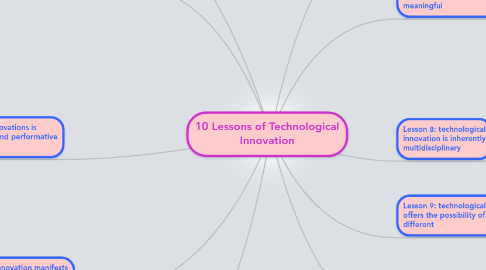
1. Lesson 3: Innovations is articulatory and performative process
1.1. Innovation is a process that involves many people, each with a specific function or task. This collective effort is THE innovation.
1.2. Innovations draw on already understood meanings and either changes them or adds to them. For the innovation to be understood it has to have meaning it cannot be arbitrary.
1.3. Articulation: both the process of meaning-making and production
1.3.1. "as the process of meaning-making, articulation describes the practice of forging associations among signifying elements"
1.3.1.1. an element gains its meaning, in part, from its association with other elements in the group.
1.3.2. the articulation of elements forms a formation which becomes the innovation
2. Lesson 4: Innovation manifests the dual logic of technological reproduction
2.1. Dual Logic: technological innovations not only replicate previous elements but they also create new elements through the development of new materials, creation new functionalities, or the new combination of prior components
2.1.1. This process is reproductive! Reproduction has two fundamental processes: 1) replication and 2) expression.
2.1.1.1. Expression: when materials from a previous technology take on a new context
2.1.2. Because of this dual logic, developers and designers must understand that an innovation has no specific time and place but can constantly be evolved. Once this is understood, there will be no limits on technological imagination.
3. Lesson 5: designing is an important process of cultural reproduction
3.1. Designing ecompasses a range of expressive practices. By engaging in these practices, they manifest creativity
3.1.1. storytelling, sketching, image making, storyboarding and compossing
3.1.2. Creativity is cultural construct
3.2. Culture is both a resource for, and an outcome of, the designing process
4. Lesson 2: Innovations are not objects
4.1. not simply things--a combination of physical artifacts, infrastructures and social elements--hybrid socio-technical-cultural assemblages
4.1.1. artifacts: hardware, devices and tools
4.1.2. infrastructures: two kinds, material and immaterial
4.1.2.1. material: highways, power sources
4.1.2.2. immaterial: codes and technical standards
4.1.3. Social elements: social practices and structures
4.1.3.1. social practices: rituals and habits remediated by innovative devices
4.1.3.2. Social structures: use of machines, enactment of policies and imposition of laws
5. Lesson 1: Innovations are historically constituted
5.1. Innovations are developed within a technoculture formation
5.1.1. Technoculture is contingent on specific historical actions and forces
5.1.1.1. Innovation develops alongside cultural reproduction
5.1.1.1.1. Special Note: Cultural Reproduction--the process whereby culture is renewed, reenacted and regenerated
6. Lesson 7: designing is a process where the matter of the world becomes meaningful
6.1. "designers are instrumental in the process whereby materiality of the world becomes meaningful technologically and culturally.
6.1.1. these meanings are created through the production of objects: digital and/or material, representational and/or gestational, theoretical and/or physical
6.1.1.1. objects also partcipate in the design process because they evoke knowledge, stimulate discussion and manifest the matter of the world.
7. Lesson 8: technological innovation is inherently multidisciplinary
7.1. designers must identify the multiple contexts where technologies take shape and have effects
7.1.1. several expertise are required to a have success innovation. artists and humanist can learn the protocol and technology from engineers and technologists. engineers and technologists can gain insights to interpretation and analysis. each has their own contribution to make in the process
8. Lesson 9: technological innovation offers the possibility of doing things different
8.1. during the design process nothing is set in stone and therefore changes can be made at anytime. these moments allow for new ideas and meanings to develop.
9. Lesson 6: designing is as much about social negotiation as it is about creativity
9.1. all the elements of design culminate in the final process of meaning-making and negotiation. because designing is based on the success or failure of human interaction with the design, designers have to negotiate and establish social meaning and understanding of their design
10. Lesson 10: failure is productive
10.1. Balsamo does not emphasize the positive effect failure can have on the innovation process.
10.1.1. culture has struggle and struggle can be failure. if you learn from it, it can be a productive tool.

